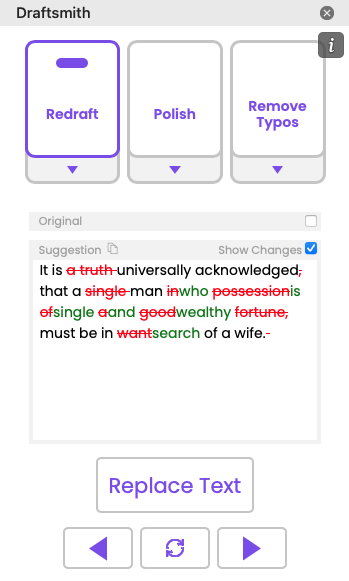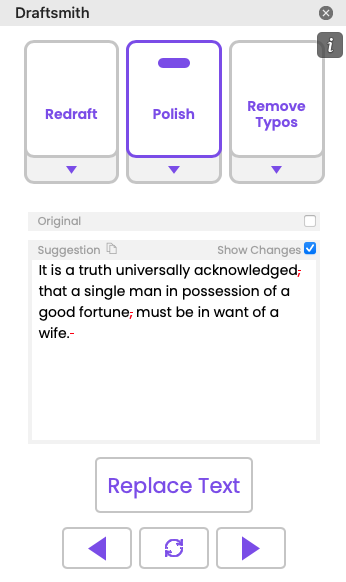Perrin Lindelauf
“Draftsmith is an intriguing toolbox from a trusted app developer in the editing community. By working within Word, with Track Changes and with privacy in mind, it brings AI text manipulation to the editing field”
Perrin Lindelauf (he/him) is a developmental and copy editor living on the unceded territories of the K’omok First Nation of Vancouver Island. As a tech enthusiast, he’s been pushing himself to learn and use the latest AI tools to have a better sense of where the industry is headed. Away from the keyboard, he’s father to one wordy toddler and an avid (read: slow) marathoner.
Perrin Lindelauf for The Editors’ Weekly
Draftsmith: An Editor’s Review
Intelligent Editing’s PerfectIt has long been the consistency software standard for editors, so when the rapid AI advances of the last year began flipping industries on its head, I grew curious about how the company would keep pace.
Its response is Draftsmith, a new AI writing refiner that promises to bridge the gap between lacklustre AI-generated text and the final, human-approved draft. Built on Microsoft’s Azure OpenAI Service, Draftsmith, like many text-wrangling services that have popped up over the past year, is based on OpenAI’s ChatGPT. The difference lies in the secret sauce of extra training that the AI model receives to limit and focus its area of expertise. For editors, Draftsmith’s merits become clearest when compared to ChatGPT’s standard setting (and the way Draftsmith avoids some of ChatGPT’s pitfalls).
Function and privacy
Foremost, Draftsmith is a Microsoft Word plugin. This means that it can edit manuscripts directly — it isn’t necessary to give a prompt to ChatGPT and then paste the results in.
Second, it works with Track Changes, inserting edits with your username and making the minimal number of changes necessary. In contrast, you can paste an error-filled paragraph into ChatGPT for grammar and typo fixes, but it merely provides the corrected text without highlighting or tracking each edit. This forces the user to search for each change and manually type them into the manuscript they are editing.
Third, by getting at OpenAI through Azure, Draftsmith keeps your text encrypted and private (whereas all text entered into ChatGPT is used to further train and refine the AI model).
Finally, since Draftsmith doesn’t offer text generation, it doesn’t fall into the pitfall of hallucination — making up nonsense — that ChatGPT can sometimes suffer from. Thus, before we even look at specific features, it is clear that Draftsmith gets around many concerns that editors have about AI services in their work.
Unfortunately, Draftsmith isn’t able to completely avoid the intellectual property and copyright criticisms that face all AI tools based on OpenAI: its Large Language Model was built by scraping the internet over the past eight years, studying Reddit posts and Wikipedia, and processing internet-based book collections. Whether OpenAI has committed wholesale infringement or fair use remains to be seen.
Draftsmith’s toolset
Draftsmith offers a suite of tools to aid in the revision process for writers. These have varying degrees of utility for editors. Choosing a tool opens a sidebar with three text-refining tools and a text window to display the proposed edit.
For this review, I have focused on the tools I believe will be the most useful for editors: Editing Helper, Readability Tuner, Plain English Converter and Word Count Trimmer.
Copy editing with Draftsmith
The Editing Helper offers Redraft (a copy edit pass with restructuring for clarity), Polish (a copy edit without sentence restructuring) and the self-explanatory Remove Typos.
Unlike PerfectIt (or competitor Grammarly), which will chew on long manuscripts, Draftsmith’s preview window appears to be limited to two sentences at a time. This limit is usually fine for Redraft, as you’ll want to consider each sentence revision individually, but the lack of awareness of preceding and following sentences may create stylistic problems within paragraphs if the tone abruptly changes. I also found myself wishing that Remove Typos could handle a whole document like a smarter spell check.
I ran the famous first line from Jane Austen’s Pride and Prejudice through both Redraft and Polish.
As you can see, Redraft prefers a more straightforward structure, whereas Polish retains Austen’s structure but dispenses with the archaic commas. In both cases, Draftsmith does a good job of not introducing errors.
Adjusting readability
Next in line for editors would be the Readability Tuner and Plain English Converter. The first offers buttons to simplify text to target one of two Flesch-Kincaid reading levels (Eleven-Year-Old Reading or High School Reading). The Simplify button rewrites with shorter sentences, simpler grammar and more common vocabulary.
The Plain English Converter offers the Simplify button once again — indeed, many of the tools share features. (Initially, the reuse of tools seemed redundant, but Intelligent Editing is trying to offer the most useful tools through the lens of a particular task.) There is also a Plain English tool to avoid jargon, technical terms and wordiness. The College Reading tool, on the other hand, will either make text simpler or more complex to achieve this Flesch-Kincaid level.
To test these features, I ran the opening line of A Hitchhiker’s Guide to the Galaxy (Douglas Adams) through.
Plain English is basically straightforward, although I wonder whether “unpopular” would be plainer than “unfashionable.” Simplify does pare the sentence down, but it loses the sense that a story is being told. College Reading is interesting: it keeps the prepositional phrase at the end but dispenses with the five-dollar words. I guess these hypothetical college kids aren’t English majors. Another surprise: the Eleven-Year-Old Reading tool maintains the inverted structure but swaps in “there is” for “lies.”
Reducing word count
The Word Count Trimmer tool is useful for editors trying to meet word count targets. It aims to cut extraneous words without impacting meaning. However, the Simplify tool can save even more words through its dramatic revisions. Redraft, appearing again from the Editing Helper, lets editors consider different structures that may be somewhat shorter. This time, I tested the lengthy (119-word) intro sentence to A Tale of Two Cities (Charles Dickens).
The Reduce Word Count tool helpfully says that 50 words were cut, something I wish were included in the other two tools. Doing the math myself, I found that Simplify cut out 65 words, and Redraft cut 54 words — but when I clicked back to the Redraft results to count, Draftsmith generated a totally new revision of the opening line, this time cutting 51 words.
I was surprised to lose my initial results so easily; perhaps the developers will put in a “pin” feature to save good results temporarily while you play with other tools.
Final thoughts on Draftsmith
Draftsmith is an intriguing toolbox from a trusted app developer in the editing community. By working within Word, with Track Changes and with privacy in mind, it brings AI text manipulation to the editing field and answers many qualms that my colleagues have expressed.
This is certainly a 1.0 release, but as the app develops, I hope it is eventually able to process more text at once. I see myself using Redraft and Simplify on tangled, jargony sentences to get editing options when I would otherwise spend several minutes pulling out what’s left of my hair.
—
The Editors’ Weekly is the official blog of Editors Canada. Contact us.
Written by Perrin Lindelauf
Perrin Lindelauf (he/him) is a developmental and copy editor living on the unceded territories of the K’omok First Nation of Vancouver Island. As a tech enthusiast, he’s been pushing himself to learn and use the latest AI tools to have a better sense of where the industry is headed. Away from the keyboard, he’s father to one wordy toddler and an avid (read: slow) marathoner.











